Physical Address
304 North Cardinal St.
Dorchester Center, MA 02124
The synovial membrane forms the lining of joints, tendons, and bursae. In addition, its cells synthesize hyaluronate, a major component of synovial fluid, and facilitate the exchange of substances between blood and synovial fluid. The synovial membrane varies considerably in appearance, depending on local mechanical factors and the nature of the underlying tissue. The synovial surface of joints subjected to high pressure is flat and acellular, whereas joints under less stress have a redundant surface lined by cells that resemble cuboidal or columnar epithelium. Unlike epithelial lining cells, the synovial cells do not rest on a basal lamina but blend with the underlying stromal elements, occasionally forming an incomplete layer at the surface only. Therefore, joint fluid and blood vessels come in close contact with each other, a relationship that probably enhances solute exchange between the two compartments.
Electron microscopy shows that the synovial membrane is composed of two cell types. Type A cells are found beneath the surface and are characterized by filopodia that extend upward and form a ramifying network of overlapping processes devoid of junctional attachments. Under appropriate conditions, these cells engage in phagocytosis. The surface synoviocytes are termed type B cells . These cells have ovoid nuclei and long cytoplasmic processes that circumferentially surround the nucleus. Although seemingly different, these cells probably represent functional modulations of the same cell because transitional forms are often seen. Both cells are embedded in a collagen-rich extracellular matrix with pools of amorphous ground substance. On immunohistochemistry (IHC), synoviocytes express clusterin (a chaperone glycoprotein involved in lipid recycling and apoptosis) and podoplanin (D2-40), show variable expression of desmin, and are negative for CD163 and other histiocyte-specific markers, such as CD11c. They are negative for keratins.
A number of benign tumors and tumorlike lesions arise in the synovium, such as chondroma of the tendon sheath, fibroma of the tendon sheath, synovial chondromatosis, and synovial hemangioma, but only the tenosynovial giant cell tumor (TGCT) is considered a true neoplasm of synoviocytes. This tumor is the most common benign tumor of the tendon sheath and synovium and is the only one that is histogenetically derived from synoviocytes.
The most significant early contribution to the understanding of tenosynovial giant cell tumor was made by Jaffe, who regarded the synovium of the tendon sheath, bursa, and joint as an anatomic unit that could give rise to a common family of lesions. Tumors arising in association with a tendon were termed giant cell tumor of tendon sheath . Those arising outside of a tendon in the synovium, and hence generally in an intraarticular location, were termed pigmented villonodular synovitis (PVNS) . Although either form could be localized or diffuse, giant cell tumor of tendon sheath was more often localized and PVNS was more often diffuse. As this terminology is still commonly used in the orthopedic community, it behooves the pathologist to be familiar with it; however, the preferred pathologic nomenclature is tenosynovial giant cell tumor (TGCT) for all lesions within this spectrum, with the added designation of localized or diffuse based on growth pattern.
The localized type primarily affects the digits and arises from the synovium of tendon sheaths or interphalangeal joints. The diffuse form occurs in areas adjacent to large weight-bearing joints such as the knee and ankle and, in many instances, represents an extraarticular extension of TGCT. A small number of diffuse TGCTs have no intraarticular component and probably originate from bursae associated with large joints. TGCT restricted to the joint proper is not specifically discussed in this chapter.
The localized form of TGCT is characterized by a discrete proliferation of rounded synoviocyte-like cells accompanied by a variable number of multinucleated giant cells, inflammatory cells, siderophages, and xanthoma cells.
Tenosynovial giant cell tumor may occur at any age but is most common in patients 30 to 50 years old. Women are affected about two to three times as often as men. The tumors occur predominantly on the hand, where they represent the most common neoplasm of that region ( Figs. 25.1 and 25.2 ). Less common sites include the feet, ankles, and knees. In the study by Ushijima et al., 183 of 208 tumors occurred in the digits, usually one of the fingers (158 cases); only 25 tumors were found in the larger joints, including the ankle/foot (10 cases), knee (8), wrist (6), and elbow (1 case). Finger lesions are typically located adjacent to the interphalangeal joint, although other sites may also be affected. Occasionally, this tumor can arise in an intraarticular location, but should be distinguished from pigmented villonodular synovitis on clinical and radiographic grounds.
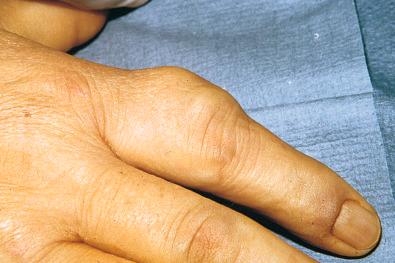
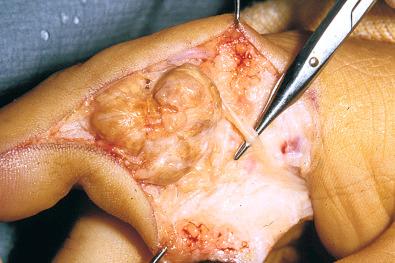
The tumors develop gradually as a painless swelling over a long period and often remain the same size for several years. On physical examination, they are fixed to deep structures but are usually not attached to skin unless the lesion occurs in the distal portion of the fingers where skin is closely related to tendon. Serum cholesterol levels are invariably normal. Antecedent trauma occurs in a variable number of patients, but its association with the lesions is likely coincidental. Radiographic studies usually demonstrate a circumscribed soft tissue mass and, occasionally, degenerative changes of the adjacent joint. Only about 10% of patients, however, have cortical erosion of bone, and bony invasion is exceedingly uncommon.
Localized-type tenosynovial giant cell tumor is a circumscribed lobulated mass that has occasional shallow grooves along its deep surfaces, created by the underlying tendons ( Figs. 25.3 and 25.4 ). Localized-type TGCTs are usually relatively small, ranging from 0.5 to between 3.0 and 4.0 cm in diameter. Those on the feet are often larger and more irregular in shape than those on the hands. On cut section the tumors have a mottled appearance: a pink-gray background flecked with yellow or brown, depending on the amount of lipid and hemosiderin. Tumors arising in the large joints are usually of greater size and more irregular in shape than tumors in the digits.
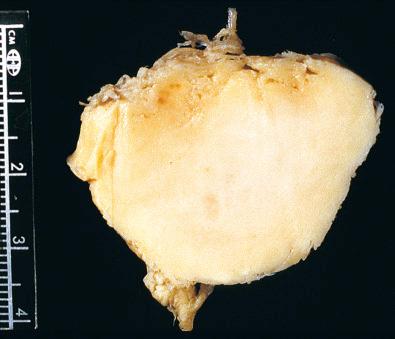
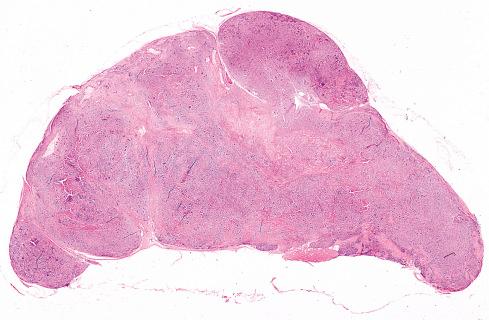
The earliest lesion is a villous structure that projects into the synovial space of the tendon sheath. Limited space prevents continued growth into the cavity, so ultimately the tumor grows outward in a cauliflower fashion and compresses synovium-lined clefts into its substance. At the stage most lesions are surgically excised, they are exophytic masses attached to the tendon sheath and have smooth but lobulated contours. They are partially invested by a dense collagenous capsule that penetrates the tumor, dividing it into vague nodules. The capsule is not totally confining because isolated nests of tumor can be identified outside its bounds, especially at the deep margin where the tumor blends with the synovial membrane.
The histologic appearance of this tumor varies, depending on the proportion of synoviocytes, histiocytes, osteoclast-like giant cells, xanthomatous histiocytes, hemosiderin, and the degree of collagenization ( Figs. 25.5 to 25.12 ). Most tumors are moderately cellular and are composed of sheets of round or polygonal cells that blend with hypocellular collagenized zones in which the cells appear slightly spindled ( Figs. 25.13 and 25.14 ). Cleftlike spaces are occasionally present, particularly in lesions arising near large joints. Some probably represent synovium-lined spaces, whereas others are artifactual spaces caused by shrinkage and loss of cellular cohesion. The synoviocytes are slightly larger than normal histiocytes, contain a moderate amount of eosinophilic cytoplasm, and sometimes display a perinuclear halo of hemosiderin pigment. Multinucleated giant cells are scattered throughout the lesions. In the typical case, giant cells are relatively numerous but may be sparse in highly cellular lesions, particularly recurrent ones. In unusual cases, giant cells may be essentially absent ( Fig. 25.10 ). On occasion these giant cell–poor lesions can be mistaken for round cell sarcomas. These osteoclast-like giant cells, which are recruited into these lesions by RANKL expression in the neoplastic synoviocytes, have a variable number of nuclei, ranging from as few as three or four to as many as 50 to 60. Xanthomatous histiocytes tend to be located at the periphery of the tumor and may be associated with cholesterol clefts ( Fig. 25.8B ). Cartilaginous and osseous metaplasia is a rare finding and is most common in tumors involving the temporomandibular joint.
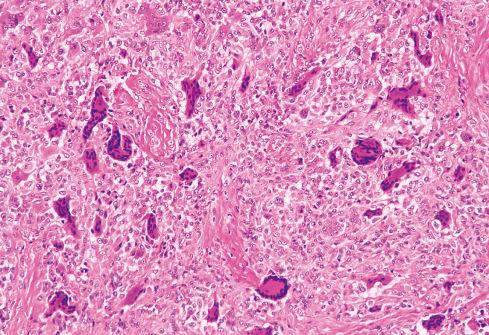
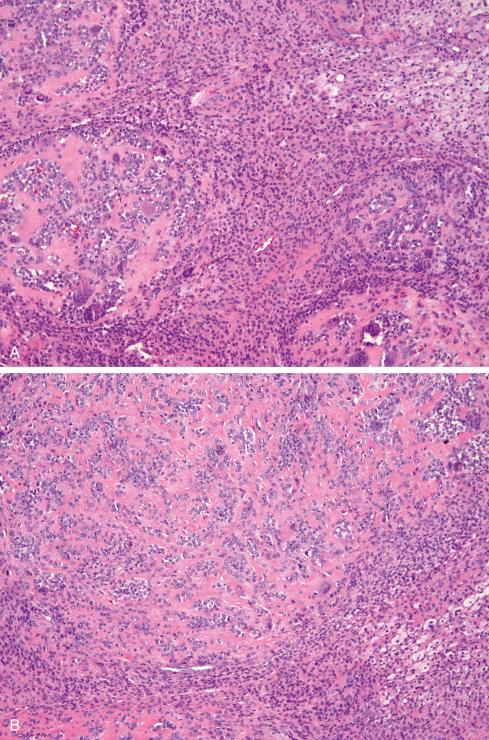
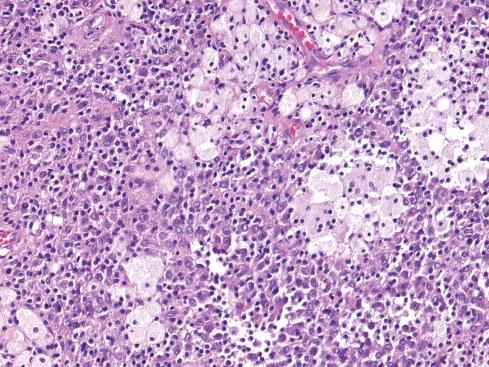
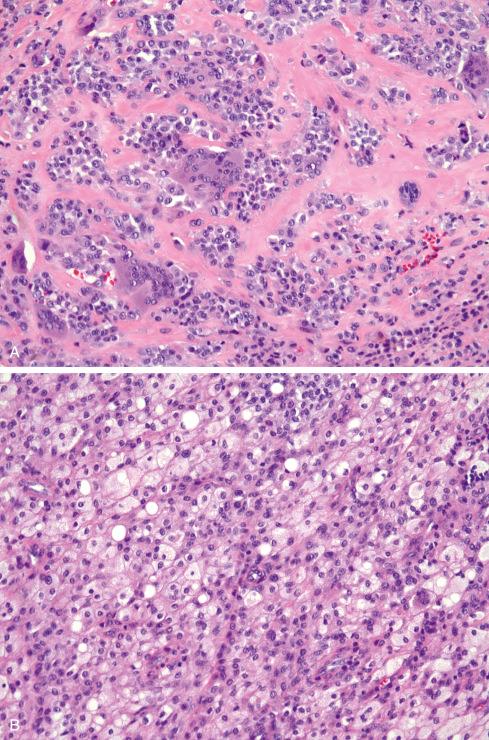
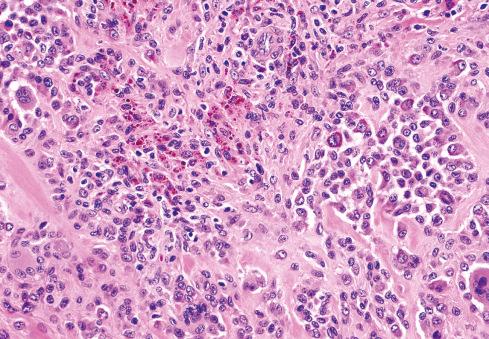
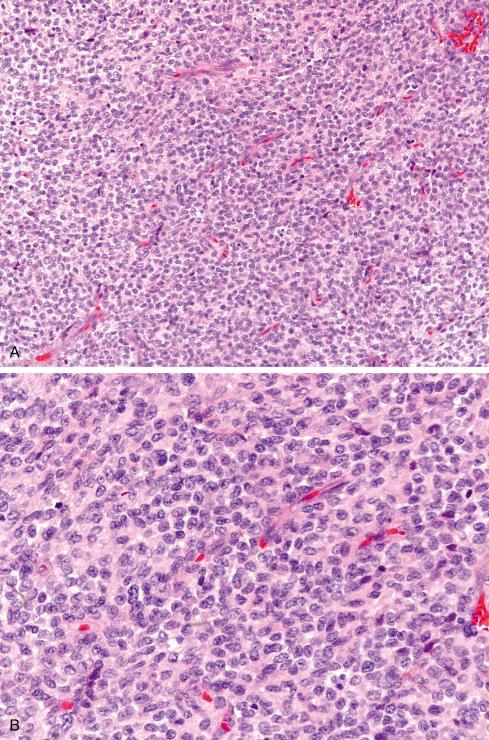
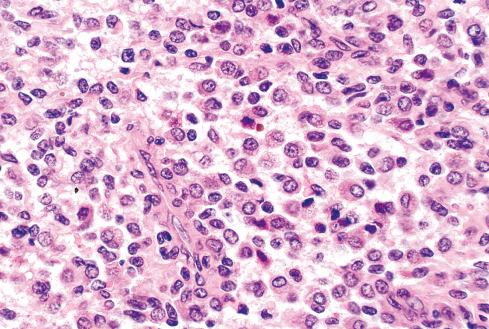
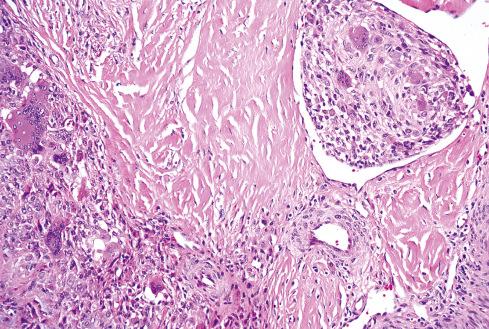
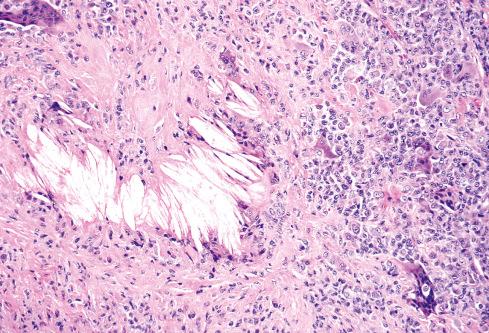
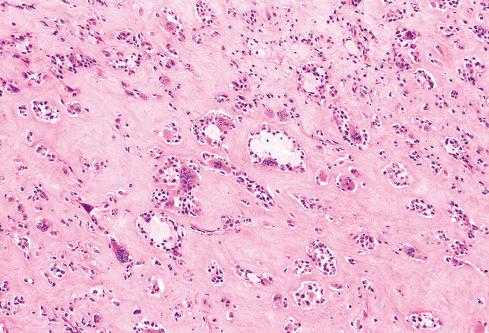
The evaluation of certain atypical features can be problematic. For example, the presence of mitotic figures occasionally leads to a mistaken diagnosis of a malignant neoplasm. Rao and Vigorita documented three or more mitotic figures per 10 high-power fields (hpf) in more than 10% of their cases. Although it may indicate an actively growing lesion that is likely to recur, mitotic activity alone should not be interpreted as evidence of malignancy in these tumors. In about 1% to 5% of cases, tumor thrombi are observed in small draining veins ( Fig. 25.12 ). Similarly, vascular invasion does not correlate with the ability to produce metastasis, based on follow-up information of cases in our experience. Focal, or occasionally near-total, infarct-type necrosis may also rarely be seen. Because of the extreme rarity of metastasizing forms of TGCT, it is justifiable to adopt a conservative approach when interpreting these atypical features. The diagnosis of malignant TGCT (see later) requires identification of nodules or sheets of clearly malignant synoviocytes.
Occasionally, other benign lesions located in the vicinity of the tendon sheath are confused with giant cell tumors, including foreign body granulomas, necrobiotic granulomas, tendinous xanthomas, and fibromas of tendon sheath. Granulomatous lesions , however, are less localized and have a greater complement of inflammatory cells. Necrobiotic granulomas are characterized by cores of degenerating collagen rimmed by histiocytes and a prominent zone of proliferating capillaries; giant cells are usually scarce or nonexistent. Although TGCT with a prominent xanthomatous component ( Fig. 25.8B ) and tendinous xanthoma formerly represented a problem in differential diagnosis, this is now seldom a practical problem for the surgical pathologist because of the recognition and early treatment of hyperlipidemia. In contrast to giant cell tumors, tendinous xanthomas that arise in the setting of hyperlipidemia are often multiple and occur in the tendon proper. Histologically, they consist almost exclusively of xanthoma cells, with only a few multinucleated giant cells and chronic inflammatory cells. Fibromas of tendon sheath bear some similarity to hyalinized forms of TGCT ( Fig. 25.14 ), and some once believed that the former represents an end-stage of the latter; this hypothesis has since been contradicted by the observation that fibromas of tendon sheath harbor USP6 rather than CSF1 gene rearrangements. In general the cells of fibroma of tendon sheath appear myo/fibroblastic and are deposited in a more uniformly hyalinized stroma, although some lesions have areas reminiscent of giant cell tumors. Occasionally, epithelioid sarcomas with numerous giant cells mimic a TGCT. The relatively monomorphic population of cells with dense cytoplasmic eosinophilia and strong and diffuse expression of keratin with loss of SMARCB1 expression distinguish it from TGCT. Clefted areas of a TGCT may also suggest the glandular component of a biphasic synovial sarcoma , but the cells lining the spaces are identical to those found in the solid portion of the tumor and lack epithelial features, as determined by IHC. These clefted or pseudoalveolar areas may also suggest alveolar rhabdomyosarcoma , particularly in tumors containing large numbers of desmin-positive cells.
Become a Clinical Tree membership for Full access and enjoy Unlimited articles
If you are a member. Log in here